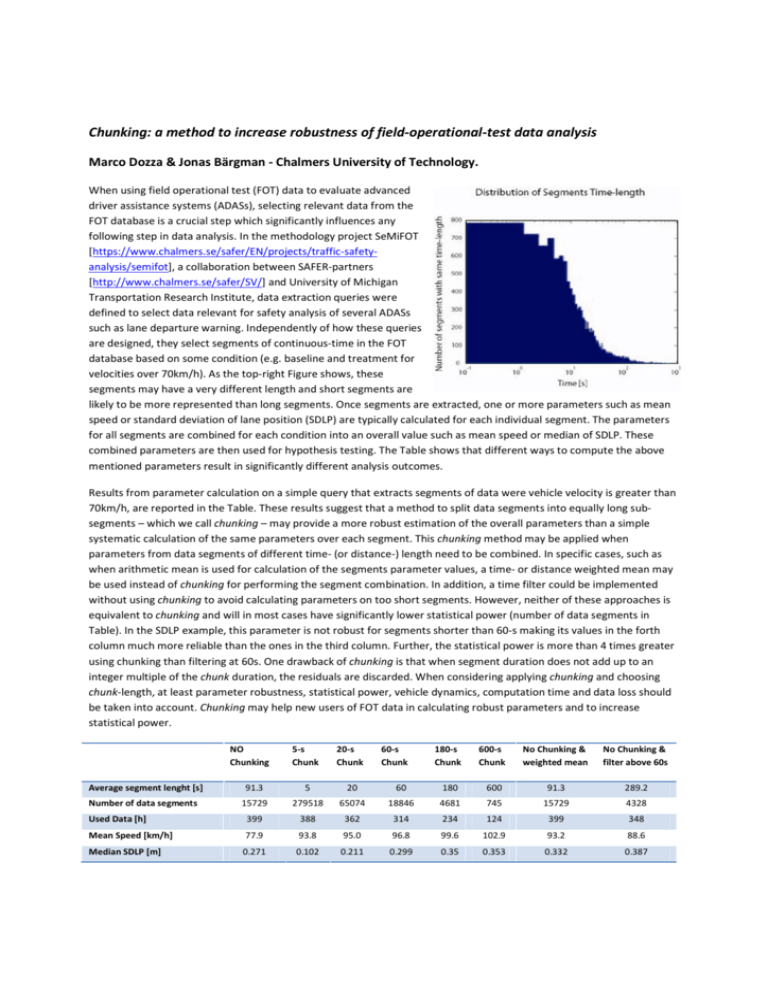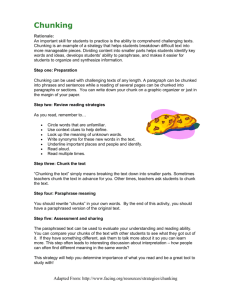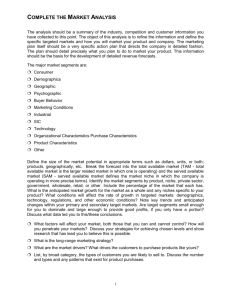Chunking: a method to increase robustness of field-operational
advertisement

Chunking: a method to increase robustness of field-operational-test data analysis Marco Dozza & Jonas Bärgman - Chalmers University of Technology. When using field operational test (FOT) data to evaluate advanced driver assistance systems (ADASs), selecting relevant data from the FOT database is a crucial step which significantly influences any following step in data analysis. In the methodology project SeMiFOT [https://www.chalmers.se/safer/EN/projects/traffic-safetyanalysis/semifot], a collaboration between SAFER-partners [http://www.chalmers.se/safer/SV/] and University of Michigan Transportation Research Institute, data extraction queries were defined to select data relevant for safety analysis of several ADASs such as lane departure warning. Independently of how these queries are designed, they select segments of continuous-time in the FOT database based on some condition (e.g. baseline and treatment for velocities over 70km/h). As the top-right Figure shows, these segments may have a very different length and short segments are likely to be more represented than long segments. Once segments are extracted, one or more parameters such as mean speed or standard deviation of lane position (SDLP) are typically calculated for each individual segment. The parameters for all segments are combined for each condition into an overall value such as mean speed or median of SDLP. These combined parameters are then used for hypothesis testing. The Table shows that different ways to compute the above mentioned parameters result in significantly different analysis outcomes. Results from parameter calculation on a simple query that extracts segments of data were vehicle velocity is greater than 70km/h, are reported in the Table. These results suggest that a method to split data segments into equally long subsegments – which we call chunking – may provide a more robust estimation of the overall parameters than a simple systematic calculation of the same parameters over each segment. This chunking method may be applied when parameters from data segments of different time- (or distance-) length need to be combined. In specific cases, such as when arithmetic mean is used for calculation of the segments parameter values, a time- or distance weighted mean may be used instead of chunking for performing the segment combination. In addition, a time filter could be implemented without using chunking to avoid calculating parameters on too short segments. However, neither of these approaches is equivalent to chunking and will in most cases have significantly lower statistical power (number of data segments in Table). In the SDLP example, this parameter is not robust for segments shorter than 60-s making its values in the forth column much more reliable than the ones in the third column. Further, the statistical power is more than 4 times greater using chunking than filtering at 60s. One drawback of chunking is that when segment duration does not add up to an integer multiple of the chunk duration, the residuals are discarded. When considering applying chunking and choosing chunk-length, at least parameter robustness, statistical power, vehicle dynamics, computation time and data loss should be taken into account. Chunking may help new users of FOT data in calculating robust parameters and to increase statistical power. NO Chunking 5-s Chunk 20-s Chunk 60-s Chunk 180-s Chunk 600-s Chunk No Chunking & weighted mean No Chunking & filter above 60s Average segment lenght [s] 91.3 5 20 60 180 600 91.3 289.2 Number of data segments 15729 279518 65074 18846 4681 745 15729 4328 Used Data [h] 399 388 362 314 234 124 399 348 Mean Speed [km/h] 77.9 93.8 95.0 96.8 99.6 102.9 93.2 88.6 Median SDLP [m] 0.271 0.102 0.211 0.299 0.35 0.353 0.332 0.387 Authors Contacts: Marco Dozza – Chalmers University of Technology, dept. of Applied Mechanics. Tel: +46 31 772 3621, e-mail: marco.dozza@chalmers.se SAFER - Box 8077 - S-402 78 - Göteborg – Sweden Jonas Bärgman – Chalmers University of Technology, dept. of Applied Mechanics. Tel: +46 31 772 5846, e-mail: jonas.bargman@chalmers.se SAFER - Box 8077 - S-402 78 - Göteborg - Sweden








